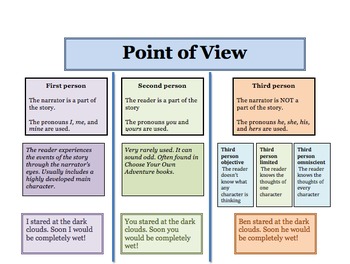Point of View: Stories and Activities
Emily Kissner
6.2k Followers
Grade Levels
4th - 6th
Subjects
Resource Type
Standards
CCSSRL.4.1
CCSSRL.4.3
CCSSRL.4.6
CCSSRL.5.1
CCSSRL.5.3
Formats Included
- Zip
Pages
90 pages
Emily Kissner
6.2k Followers
Description
Go beyond just identifying point of view with these resources. Begin with a PowerPoint that guides students in learning about first person, third person limited, and third person omniscient points of view. A study guide to accompany the PowerPoint engages students in looking at passages and answering questions. A practice activity and a card match help students to refine and review what they have learned.
Two original stories guide students into deeper reading and a stronger understanding of point of view. The first, "Stone Soup", is told from multiple points of view. Students use the different points of view to discuss the story and explore how the different points of view shape the narrative. A before reading activity, discussion questions, and a passage-based essay prompt are included.
The second story, "Unthawing", is told from a boy's point of view. Activities for this story mirror the activities for "Stone Soup". Again, the emphasis is not on identification, but use of point of view.
To see thumbnails of these activities and read the teaching guide, be sure to check out the preview.
Two original stories guide students into deeper reading and a stronger understanding of point of view. The first, "Stone Soup", is told from multiple points of view. Students use the different points of view to discuss the story and explore how the different points of view shape the narrative. A before reading activity, discussion questions, and a passage-based essay prompt are included.
The second story, "Unthawing", is told from a boy's point of view. Activities for this story mirror the activities for "Stone Soup". Again, the emphasis is not on identification, but use of point of view.
To see thumbnails of these activities and read the teaching guide, be sure to check out the preview.
Total Pages
90 pages
Answer Key
Rubric only
Teaching Duration
2 Weeks
Report this resource to TPT
Reported resources will be reviewed by our team. Report this resource to let us know if this resource violates TPT’s content guidelines.
Standards
to see state-specific standards (only available in the US).
CCSSRL.4.1
Refer to details and examples in a text when explaining what the text says explicitly and when drawing inferences from the text.
CCSSRL.4.3
Describe in depth a character, setting, or event in a story or drama, drawing on specific details in the text (e.g., a character’s thoughts, words, or actions).
CCSSRL.4.6
Compare and contrast the point of view from which different stories are narrated, including the difference between first- and third-person narrations.
CCSSRL.5.1
Quote accurately from a text when explaining what the text says explicitly and when drawing inferences from the text.
CCSSRL.5.3
Compare and contrast two or more characters, settings, or events in a story or drama, drawing on specific details in the text (e.g., how characters interact).





